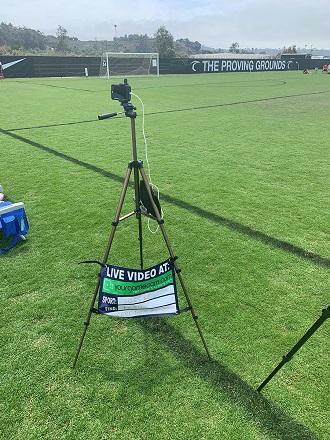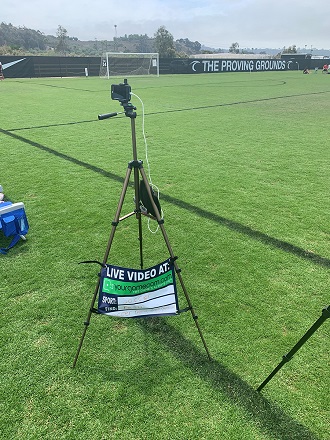

With high school sports shut down and may showcase events running without spectators, live streaming is coming into its own. The ability to record and replay games is having a two-fold benefit: bringing home the action safely and allowing youth athletes to showcase their skills to scouts and coaches for teams at the next level.
It has also increased the marketability of tournaments that offer such services – and not just to coaches. Parents, who have had their children enrolled in travel programs, and who have long staked their hopes on an athletic scholarship to pay for college, are panicking. Many report having taken out loans, working extra jobs and going into debt to pay for sports in pursuit of a free ride to college. Now, they are desperate to have their children catch the eye of a coach.
Buzzfeed News noted that the problem first surfaced at the change of seasons, along with COVID-19. It was, after all, in the early spring, when college recruitment is at its height, that COVID struck, knocking out the possibility of tournaments, showcases and in-person college visits. Young players across the country lost their most important chances to prove themselves to college coaches: end-of-season high school basketball tournaments, track meets, entire seasons of baseball and softball. Then, the NCAA's recruitment rules changed.
The summer travel league season normally offers college coaches a chance to recruit the next generation of players that will be joining their program in the future. That method of business has been turned on its head in 2020, noted an article in MLive.
“The worst part about all of this is that for the kids that are 14-17 years old, the recruiting process is basically locked up,” said Red Pastor, head of the Michigan Sabercats fastpitch softball league organization. “The reality of these kids playing in front of college coaches this summer is just not going to happen." And, he adds, an out-of-state schedule is the only option at this point.
“The Classes of 2020, 2021 and 2022 are really the ones that going to take the brunt of that punishment from the NCAA. So, we’re actually hooking up GoPros to our players and we’re using a thing called a GL, which is like a video program where we can live stream our games and college coaches can go on to the GL viewing and still see the kids that they’re trying to recruit through social media."
For many young soccer players, closures affected some of the year’s biggest, most important tournaments and showcases in club soccer, which typically bring chances for players to be seen by the college coaches intent on filling out their rosters.
And unfortunately, it's not about the elite youth players, said Travis Clark, a college soccer recruiting expert for the website TopDrawerSoccer. Most of those athletes committed long ago to top Division I programs, sometimes as early as middle school. It’s the DII and DIII programs, as well as junior colleges, that typically have a smaller window to view those athletes (generally in the spring), that have missed out on their chance to view the athletes who could fill out their rosters. And many of those schools, despite being in the lower echelon, do offer athletic scholarships.
USA TODAY notes that spring and summer are when college coaches make tracks for AAU tournaments around the nation, and although some of those tournaments are still running, they may be shorter and have a lower capacity, making them less advantageous for coaches.
Because of the pandemic, the NCAA is enforcing a recruiting dead period for July and August, preventing college coaches from watching players in person in the valuable summer months. This, in turn, has placed an increased value on live streams, and thus, on any tournament that offers such services.
Jeremy Waller, vice president of business development for Sports Channel Media and YourGameCam, believes streaming is reshaping the landscape of recruiting. His company recently inked a partnership with Prep Baseball Report (PBR), and, he notes, “There have been a number of players that have received offers just from being identified during our virtual showcases and tournaments.”
Coaches themselves are changing their recruiting tactics to adapt to the COVID landscape, he adds.
“Many of the coaches at these schools have expressed that virtual scouting will redefine their recruiting budgets. With the blackout period being extended to September 1 and many rumors circulating that it will be extended well into the spring, this time has forced them to reevaluate their pre-COVID approach.”
The need for coaches to get a better look at a specific player has driven up the functionality of streaming platforms. The New York Times recently chronicled one coach’s struggle to decide whether to send his travel team to a tournament in Las Vegas. Nudging his decision to do so was the information that the live stream for the tournament, provided by the company BeTheBeast, would not only be accessed by college coaches but that players would be notified which college coaches had watched them after they played their games.
An article in Top Drawer Soccer drives that point home, noting, “The days of crowding the sideline or gym for college recruiting are over. The pictures with a sea of lawn chairs on the touchline are a distant memory. An empty sideline or gym is a far more likely scenario in the immediate future for youth sports.”
Case in point for Top Drawer: Girls Academy League, which announced a partnership with Instat as the official video analysis. Instat, the article went on to say, allows teams to spotlight moments and touches for specific players (a function of value to the coaching staff), but the bigger appeal is the recruiting tool, offering college coaches an honest representation of a player without being there to see him or her in action. And in general, college coaches need the best video of players possible, which continues to drive the development of user-friendly features for recording and streaming platforms.
“The old complaints about the video not being a fair representation of a player’s quality or contributions are gone thanks to the innovation of companies like Instat, Hudl, Upper 90 Sports Media, and others who are advancing the way games are recorded to a level many never dreamed of just a few years ago,” the article added.
Sean Miller, founder of Upper 90 Sports Media, notes that streaming platforms are continuing to advance.
“I’ve always felt that streaming was going to be the next evolution of video,” Miller said. “I also think game analysis is the next thing that people will be taking advantage of. You see pros using game analytics. It’s the evolution of youth sport in general. If you focus that on soccer, we’re still in our infancy. The adoption rate of video is increasing every year… The next evolution of that is definitely streaming and game analytics is after that.”
Local requirements that eliminate spectators and require recording are also driving the market, as well as the development of platforms. Upper 90 recently began working with an AI outfit that automatically zooms and follows the action on the field and has been expanded to include team brochures as well as a social media component.
Several weeks ago, the National Federation of State High School Associations made an unprecedented offer through its NFHS Network, which streams live and on-demand high school sports. Through its High School Support Program, the NFHS Network began offering up to two free Pixellot automated-production units for schools that lack production capabilities to stream events on the NFHS Network. The intent was to drive not only participation in sports, but engagement as well, in the face of attendance restrictions.
The offer of two Pixellot units – one for indoor events and the other for outdoor contests – was extended to all 19,500 high schools in the 51 NFHS member state associations. In addition to receiving two free Pixellot production units, schools will receive a larger percentage of subscription revenue generated from their events, effective August 1, in an effort to offset revenue losses from reduced attendance.
“We recognize that the next several years will be challenging for our high schools and state associations,” said Mark Koski, CEO of the NFHS Network. “Many are facing budget cuts and reduced resources, and attendance at athletic and other school events may be restricted. We want the High School Support Program to demonstrate our continued commitment to help our partner schools manage through the inevitable complications created by COVID-19.”
The fact that streams will be viewable by college coaches and owners of summer travel sports organizations is likely to make the program even more valuable to schools who want to keep students on teams where it’s possible to do so safely.
The number of cameras needed by any particular entity or field can vary. Whereas some high schools may use one camera in their gym and another outside on the football field, large venues set up to host travel sports will require more.
For example, while spectator capacity is currently limited by venue on the LakePoint Sports campus in Georgia, each baseball game and event at the Champions Center will be available for streaming via LakePoint Live powered by PlaySight, the state-of-the-art AI-led live streaming and video-on-demand service. LakePoint Live features over 130 HD cameras across campus and helps make viewing the top youth athletes and games easy for college coaches, media and on- or off-site guests.
Jeremy Waller says his own company’s involvement with Prep Baseball Report is an excellent example of how streaming services are being used in the era of COVID-19.
“To date, we have had more than 175 colleges and universities sign up to access the offering,” he notes.
With youth sports just beginning to return to play, it’s too early to get any real statistics on the amount of growth streaming will see as a result of COVID-19. But if the commercial side of streaming is any indication, it will be enormous. Maria Rua Aguete, technology fellow and executive director, media, service providers, and platforms at the tech research firm Omdia, predicted up to a 50 percent increase in digital content consumption and 12 percent growth of the online streaming industry as a result of the pandemic.
